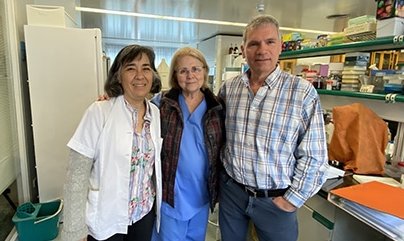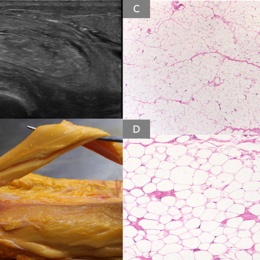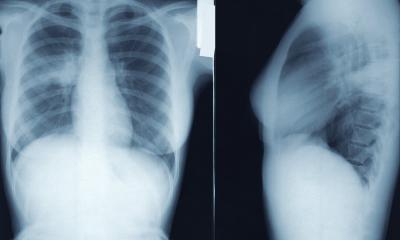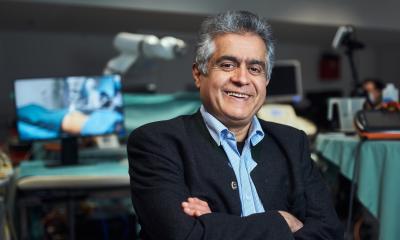
Image source: Universitat de Barcelona
News • Muscle degeneration score
New tool to diagnose and assess sarcopenia severity
Sarcopenia is a degenerative disease characterised by a pathological decrease in muscle strength that particularly affects older people. Researchers at the University of Barcelona have developed a new tool to assess the presence and severity of this muscular deterioration.
The study, published in the journal RMD Open, provides a muscle quality scoring system based on musculoskeletal ultrasound scans, which has been validated with anatomical and histological samples from patients. It is the first imaging method that assesses muscle quality, an essential factor in the disease. According to the researchers, these results could be useful "not only for diagnostic purposes but also for patient monitoring in clinical practice and clinical trials".

Images: Möller Parera et al., RMD Open 2023 (CC BY-NC 4.0)
Researchers from the Unit of Human Anatomy and Embryology and the Histology Unit of the Department of Pathology and Experimental Therapeutics of the Faculty of Medicine and Health Sciences (Bellvitge Campus) of the UB have participated in the study. Experts from the Puigvert Foundation, the University of Genoa, the University of Oslo and the University of Copenhagen also took part in the study.
A key feature of sarcopenia is the deterioration of muscle quantity and quality, which worsens the quality of life and is associated with cardiorespiratory diseases and an increased risk and prolonged hospital admission. A wide range of tests and tools are now available for disease characterisation in practice and research. "In most cases, diagnosis and progression are measured by functional tests or patient surveys on aspects such as falling, feelings of weakness, slowness in walking, difficulty getting up from a chair or weight loss, which provide information on the patient's condition," notes Ingrid Möller, researcher at the UB and the Poal Institute of Rheumatology (Barcelona) and first author of the article.
It is the starting point in a field in which there is no similar test, so we believe that it is a tool that will be extended to this and other disease
Ingrid Möller
In this context, imaging techniques play a critical role in the objective assessment of sarcopenic patients. However, most of them, such as dual-energy X-ray absorptiometry (DXA), magnetic resonance imaging (MRI) or computerized tomography (CT), focus on muscle quantity. "These techniques show the quantity of muscle, but muscle quality —which is a relatively new term— is more important, as the quantity is very variable due to different factors such as age or height", she says.
Currently, there is no universal consensus on appropriate methods of assessing muscle quality in regular clinical practices. In this situation, the researchers propose the use of musculoskeletal ultrasound, as it is a technique that can show muscle texture and changes in micro- and macroscopic aspects of muscle architecture and composition caused by sarcopenia. Moreover, unlike other imaging techniques, it is a low-cost, portable and harmless test, since it does not emit ionizing radiation.
To confirm the diagnostic validity of this new tool, the study assessed one muscle from the lower extremity (rectus femoris) and one from the upper extremity (biceps brachii) from ten donor cadavers aged 68 to 91. To do this, two researchers assessed and qualitatively scored the severity of muscle degeneration from ultrasound images and then compared the results with the anatomical and histological assessment of the cadavers.
The assessment was performed blind to the other assessor and was repeated half an hour later by each of the researchers. In addition, an assessment by an experienced histologist under the same methodological conditions was also carried out. According to the researchers, this methodology is one of the "strengths of the study, as it allows direct comparison between imaging and clinical measurements of muscle quality".
The next challenge for the researchers is to verify the scoring system in patients and test the added value of the tool in the long-term monitoring of patients with sarcopenia, as well as its application in clinical trials related to it. In this sense, as the researcher explains, the team from the University of Copenhagen that has participated in this work is going to apply the new tool in a cohort of patients to see how it works in terms of prognostic value. "We believe it works very well on diagnostics, but both in this case and in its prognostic value, it needs to be corroborated in longitudinal studies with patients", explains Ingrid Möller.
Muscle quality is an important factor in other muscle diseases as well as sarcopenia. Thus, for the researchers, musculoskeletal ultrasound could also have applications in other disorders or even in the rehabilitation of sportsmen and women, as it will allow them to gain a deeper understanding of muscle quality, its variations in different immunological, degenerative, and metabolic diseases, and the monitoring of treatments. "It is the starting point in a field in which there is no similar test, so we believe that it is a tool that will be extended to this and other disease", concludes the researcher.
Source: Universitat de Barcelona
15.03.2023














